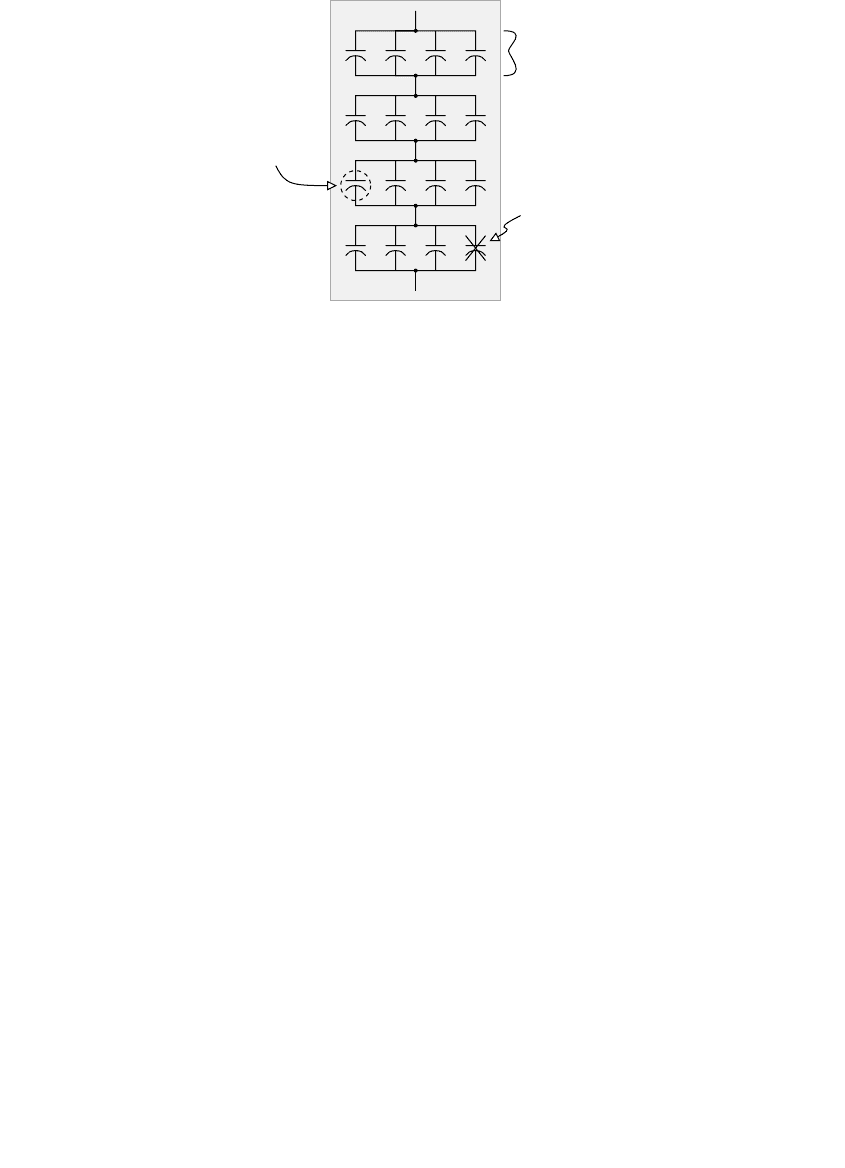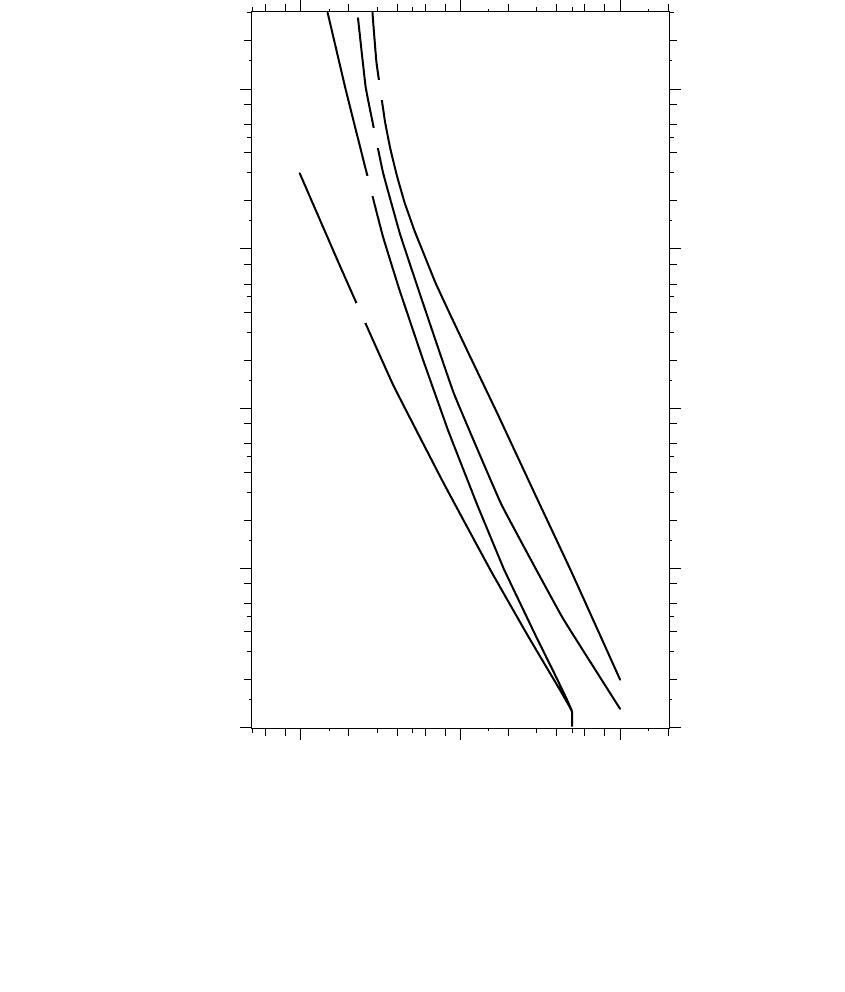Short T.A. Electric Power Distribution Handbook
Подождите немного. Документ загружается.


286 Electric Power Distribution Handbook
6.6 Local Controls
Several options for controls are available for capacitor banks:
• Time clock — The simplest scheme: the controller switches capacitors
on and off based on the time of day. The on time and the off time
are programmable. Modern controllers allow settings for weekends
and holidays. This control is the cheapest but also the most suscep-
tible to energizing the capacitor at the wrong time (due to loads
being different from those expected, to holidays or other unexpected
light periods, and especially to mistakenly set or inaccurate clocks).
Time clock control is predictable; capacitors switch on and off at
known times and the controller limits the number of switching oper-
ations (one energization and one deenergization per day).
• Temperature — Another simple control; the controller switches the
capacitor bank on or off depending on temperature. Normally these
might be set to turn the capacitors on in the range of 85 and 90∞F
and turn them off at temperatures somewhere between 75 and 80∞F.
• Voltage — The capacitor switches on and off, based on voltage. The
user provides the threshold minimum and maximum voltages as
well as time delays and bandwidths to prevent excessive operations.
Voltage control is most appropriate when the primary role of a
capacitor is voltage support and regulation.
• Vars — The capacitor uses var measurements to determine switch-
ing. This is the most accurate method of ensuring that the capacitor
is on at the appropriate times for maximum reduction of losses.
• Power factor — Similar to var control, the controller switches capac-
itors on and off based on the measured power factor. This is rarely
used by utilities.
• Current — The capacitor switches on and off based on the line current
(as measured downstream of the capacitor). While not as effective
as var control, current control does engage the capacitor during
heavy loads, which usually corresponds to the highest needs for vars.
Many controllers offer many or all of these possibilities. Many are usable
in combination; turn capacitors on for low voltage or for high temperature.
Var, power factor, voltage, or current controllers require voltage or current
sensing or both. To minimize cost and complexity, controllers often switch
all three phases using sensors on just one phase. A control power transformer
is often also used to sense voltage. While unusual, Alabama Power switches
each phase independently depending on the var requirements of each phase
(Clark, 2001); this optimizes loss reduction and helps reduce unbalance.
Because capacitor structures are rather busy, some utilities like to use voltage
1791_book.fm Page 286 Monday, August 4, 2003 3:20 PM
(C) 2004 by CRC Press LLC

Capacitor Application 287
and/or current-sensing insulators. Meter-grade accuracy is not needed for
controlling capacitors.
To coordinate more than one capacitor with switched var controls, set the
most-distant unit to have the shortest time delay. Increase the time delay on
successive units progressing back to the substation. This leaves the unit
closest to the substation with the longest time delay. The most distant unit
switches first. Upstream units see the change and do not need to respond.
This strategy is the opposite of that used for coordinating multiple line
voltage regulators.
For var-controlled banks, locate the current sensor on the source (substa-
tion) side of the bank. Then, the controller can detect the reactive power
change when the capacitor switches. To properly calculate vars, the wiring
for the CT and PT must provide correct polarities to the controller.
One manufacturer provides the following rules of thumb for setting var
control trip and close settings (Fisher Pierce, 2000):
• Close setpoint: 2/3 ¥ capacitor bank size (in kvar), lagging.
•Trip setpoint: Close set point – 1.25 ¥ bank size, will be leading. (This
assumes that the CT is on the source side of the bank.)
For a 600-kvar bank application, this yields
Close setpoint: 2/3 ¥ 600 = +400 kvar (lagging)
Trip setpoint: 400 – 1.25 ¥ 600 = –350 kvar (leading)
For this example, the unit trips when the load kvar drops below +250 kvar
(lagging). This effectively gives a bandwidth wide enough (+400 to +250
kvar) to prevent excessive switching operations in most cases.
Voltage-controlled capacitor banks have bandwidths. Normally, we want
the bandwidth to be at least 1.5 times the expected voltage change due to
the capacitor bank. Ensure that the bandwidth is at least 3 or 4 V (on a 120-
V scale). Set the trip setting below the normal light-load voltage (or the bank
will never switch off).
If a switched capacitor is located on a circuit that can be operated from
either direction, make sure the controller mode can handle operation with
power flow in either direction. Time-of-day, temperature, and voltage control
are not affected by reverse power flow; var, current, and power factor control
are affected. Some controllers can sense reverse power and shift control
modes. One model provides several options if it detects reverse power:
switch to voltage mode, calculate var control while accounting for the effect
of the capacitor bank, inhibit switching, trip and lock out the bank, or close
and hold the bank in. If a circuit has distributed generation, we do not want
to shift modes based on reverse power flow; the controller should shift
modes only for a change in direction to the system source.
1791_book.fm Page 287 Monday, August 4, 2003 3:20 PM
(C) 2004 by CRC Press LLC

288 Electric Power Distribution Handbook
Capacitor controllers normally have counters to record the number of
operations. The counters help identify when to perform maintenance and
can identify control-setting problems. For installations that are excessively
switching, modify control settings, time delays, or bandwidths to reduce
switching. Some controllers can limit the number of switch operations within
a given time period to reduce wear on capacitor switches.
Voltage control provides extra safety to prevent capacitors from causing
overvoltages. Some controllers offer types of voltage override control; the
primary control may be current, vars, temperature, or time of day, but the
controller trips the bank if it detects excessive voltage. A controller may also
restrain from switching in if the extra voltage rise from the bank would push
the voltage above a given limit.
6.7 Automated Controls
Riding the tide of lower-cost wireless communication technologies, many
utilities have automated capacitor banks. Many of the cost reductions and
feature improvements in communication systems have resulted from the
proliferation of cellular phones, pagers, and other wireless technologies used
by consumers and by industry. Controlling capacitors requires little band-
width, so high-speed connections are unnecessary. This technology changes
quickly. The most common communications systems for distribution line
capacitors are 900-MHz radio systems, pager systems, cellular phone sys-
tems, cellular telemetric systems, and VHF radio. Some of the common
features of each are
• 900-MHz radio — Very common. Several spread-spectrum data
radios are available that cover 902–928 MHz applications. A private
network requires an infrastructure of transmission towers.
• Pager systems — Mostly one-way, but some two-way, communica-
tions. Pagers offer inexpensive communications options, especially
for infrequent usage. One-way communication coverage is wide-
spread; two-way coverage is more limited (clustered around major
cities). Many of the commercial paging networks are suitable for
capacitor switching applications.
• Cellular phone systems — These use one of the cellular networks to
provide two-way communications. Many vendors offer cellular
modems for use with several cellular networks. Coverage is typically
very good.
• Cellular telemetric systems — These use the unused data component
of cellular signals that are licensed on existing cellular networks.
They allow only very small messages to be sent — enough, though,
1791_book.fm Page 288 Monday, August 4, 2003 3:20 PM
(C) 2004 by CRC Press LLC

Capacitor Application 289
to perform basic capacitor automation needs. Coverage is typically
very good, the same as regular cellular coverage.
• VHF radio — Inexpensive one-way communications are possible
with VHF radio communication. VHF radio bands are available for
telemetry uses such as this. Another option is a simulcast FM signal
that uses extra bandwidth available in the commercial FM band.
Standard communication protocols help ease the building of automated
infrastructures. Equipment and databases are more easily interfaced with stan-
dard protocols. Common communication protocols used today for SCADA
applications and utility control systems include DNP3, IEC 870, and Modbus.
DNP 3.0 (Distributed Network Protocol) is the most widely used standard
protocol for capacitor controllers (DNP Users Group, 2000). It originated in
the electric industry in America with Harris Distributed Automation Prod-
ucts and was based on drafts of the IEC870-5 SCADA protocol standards
(now known as IEC 60870-5). DNP supports master–slave and peer-to-peer
communication architectures. The protocol allows extensions while still pro-
viding interoperability. Data objects can be added to the protocol without
affecting the way that devices interoperate. DNP3 was designed for trans-
mitting data acquisition information and control commands from one com-
puter to another. (It is not a general purpose protocol for hypertext,
multimedia, or huge files.)
One-way or two-way — we can remotely control capacitors either way.
Two-way communication has several advantages:
• Feedback — A local controller can confirm that a capacitor switched
on or off successfully. Utilities can use the feedback from two-way
communications to dispatch crews to fix capacitor banks with blown
fuses, stuck switches, misoperating controllers, or other problems.
• Voltage/var information — Local information on line var flows and
line voltages allows the control to more optimally switch capacitor
banks to reduce losses and keep voltages within limits.
• Load flows — Voltage, current, and power flow information from
pole-mounted capacitor banks can be used to update and verify
load-flow models of a system. The information can also help when
tracking down customer voltage, stray voltage, or other power qual-
ity problems. Loading data helps utilities monitor load growth and
plan for future upgrades. One utility even uses capacitor controllers
to capture fault location information helping crews to locate faults.
When a controller only has one-way communications, a local voltage over-
ride control feature is often used. The controller blocks energizing a capacitor
bank if doing so would push the voltage over limits set by the user.
Several schemes and combinations of schemes are used to control capac-
itors remotely:
1791_book.fm Page 289 Monday, August 4, 2003 3:20 PM
(C) 2004 by CRC Press LLC

290 Electric Power Distribution Handbook
• Operator dispatch — Most schemes allow operators to dispatch dis-
tribution capacitors. This feature is one of the key reasons utilities
automate capacitor banks. Operators can dispatch distribution
capacitors just like large station banks. If vars are needed for trans-
mission support, large numbers of distribution banks can be
switched on. This control scheme is usually used in conjunction with
other controls.
• Time scheduling — Capacitors can be remotely switched, based on
the time of day and possibly the season or temperature. While this
may seem like an expensive time control, it still allows operators to
override the schedule and dispatch vars as needed.
• Substation var measurement — A common way to control feeder
capacitors is to dispatch based on var/power factor measurements
in the substation. If a feeder has three capacitor banks, they are
switched on or off in some specified order based on the power factor
on the feeder measured in the substation.
• Others — More advanced (and complicated) algorithms can dispatch
capacitors based on a combination of local var measurements and
voltage measurements along with substation var measurements.
6.8 Reliability
Several problems contribute to the overall reliability or unreliability of capac-
itor banks. In a detailed analysis of Kansas City Power & Light’s automated
capacitor banks, Goeckeler (1999) reported that blown fuses are KCP&L’s
biggest problem, but several other problems exist (Table 6.7). Their automa-
TABLE 6.7
Maintenance Needs Identified by Kansas City Power & Light’s
Capacitor Automation System Based on Two Years of Data
Problem
Annual Percent
Failures
Primary fuse to capacitor blown (nuisance fuse operation) 9.1
Failed oil switches 8.1
Hardware accidentally set to “Local” or “Manual” 4.2
Defective capacitor unit 3.5
Miscellaneous 2.4
Control power transformer 1.5
TOTAL 28.8
Source: Goeckeler, C., “Progressive Capacitor Automation Yields Economic and
Practical Benefits at KCPL,” Utility Automation, October 1999.
1791_book.fm Page 290 Monday, August 4, 2003 3:20 PM
(C) 2004 by CRC Press LLC

Capacitor Application 291
tion with two-way communications allowed them to readily identify bank
failures. The failure rates in Table 6.7 are high, much higher than most
distribution equipment. Capacitor banks are complicated; they have a lot of
equipment to fail; yet, failure rates should be significantly better than this.
An EPRI survey on capacitor reliability found wide differences in utilities’
experience with capacitors (EPRI 1001691, 2002). Roughly one-third of sur-
vey responses found feeder capacitors “very good,” another one-third
found them “typical of line equipment,” and the final third found them
“problematic.” The survey along with follow-up contacts highlighted sev-
eral issues:
• Misoperation of capacitor fuses — Many utilities have operations of
fuses where the capacitor bank is unharmed. This can unbalance
circuit voltages and reduce the number of capacitors available for
var support. Review fusing practices to reduce this problem.
• Controllers — Controllers were found “problematic” by a significant
number of utilities. Some utilities had problems with switches and
with the controllers themselves.
• Lightning and faults — In high-lightning areas, controllers can fail
from lightning. Controllers are quite exposed to lightning and
power-supply overvoltages during faults. Review surge protection
practices and powering and grounding of controllers.
• Human element — Many controllers are set up incorrectly. Some
controllers are hard to program. And, field crews often do not have
the skills or proper attitudes toward capacitors and their controls.
At some utilities, crews often manually switch off nearby capacitors
(and often forget to turn them back on after finishing their work).
To reduce these problems, properly train crews and drive home the
need to have capacitors available when needed.
6.9 Failure Modes and Case Ruptures
Capacitors can fail in two modes:
• Low current, progressive failure — The dielectric fails in one of the
elements within the capacitor (see Figure 6.11). With one element
shorted, the remaining elements in the series string have increased
voltage and higher current (because the total capacitive impedance
is lower). With more stress, another element may short out. Failures
can cascade until the whole string shorts out. In this scenario, the
current builds up slowly as elements successively fail.
1791_book.fm Page 291 Monday, August 4, 2003 3:20 PM
(C) 2004 by CRC Press LLC

292 Electric Power Distribution Handbook
• High current — A low-impedance failure develops across the capac-
itor terminals or from a phase terminal to ground. A broken connec-
tor could cause such a fault.
Most failures are progressive. Sudden jumps to high current are rare. To
detect progressive failures quickly, fusing must be very sensitive. Film-foil
capacitors have few case ruptures — much less than older paper units. An
EPRI survey of utilities (EPRI 1001691, 2002) found that film-foil capacitor
ruptures were rare to nonexistent. This contrasts sharply with paper capac-
itors, where Newcomb (1980) reported that film/paper capacitors ruptured
in 25% of failures.
Paper and paper-film capacitors have an insulating layer of paper between
sheets of foil. When a breakdown in a pack occurs, the arc burns the paper
and generates gas. In progressive failures, even though the current is only
somewhat higher than normal load current, the sustained arcing can create
enough gas to rupture the enclosure. Before 1975, capacitors predominantly
used polychlorinated biphenyls (PCB) as the insulating liquid. Environmen-
tal regulations on PCB greatly increased the costs of cleanup if these units
ruptured (US Environmental Protection Agency 40 CFR Part 761 Polychlo-
rinated Biphenyls (PCBs) Manufacturing, Processing, Distribution in Com-
merce, and Use Prohibitions). The environmental issues and safety concerns
led utilities to tighten up capacitor fusing.
In modern film-foil capacitors, sheets of polypropylene film dielectric sep-
arate layers of aluminum foil. When the dielectric breaks down, the heat
from the arc melts the film; the film draws back; and the aluminum sheets
weld together. With a solid weld, a single element can fail and not create
any gas (the current is still relatively low). In film-foil capacitors, the pro-
gressive failure mode is much less likely to rupture the case. When all of the
FIGURE 6.11
Capacitor unit with a failed element.
Individual
element
Failed element
Series section
1791_book.fm Page 292 Monday, August 4, 2003 3:20 PM
(C) 2004 by CRC Press LLC

Capacitor Application 293
packs in series fail, high current flows through the capacitor. This can gen-
erate enough heat and gas to rupture the capacitor if it is not cleared quickly.
Figure 6.12 shows capacitor-rupture curves from several sources. Most
case-rupture curves are based on tests of prefailed capacitors. The capacitors
are failed by applying excessive voltage until the whole capacitor is broken
down. The failed capacitor is then subjected to a high-current short-circuit
FIGURE 6.12
Capacitor rupture curves. (Data from [ANSI/IEEE Std. 18-1992; Cooper Power Systems, 1990;
General Electric, 2001].)
1
2
3
4
1: Cooper
2: GE, 300 kvar and above
3: NEMA film/foil
4: NEMA paper-film
10
+2
10
+3
10
+4
0.01
0.1
1.0
10.0
100.0
Current, amperes
Time, seconds
1791_book.fm Page 293 Monday, August 4, 2003 3:20 PM
(C) 2004 by CRC Press LLC

294 Electric Power Distribution Handbook
source of known amperage for a given time. Several such samples are tested
to develop a case-rupture curve.
The case-rupture curves do not represent all failure modes. Such curves
do not show the performance during the most common failures: low-current
and progressive element failures (before all elements are punctured).
Although, thankfully, rare, high-current faults more severe than those tested
for the rupture curves are possible. An arc through the insulating dielectric
fluid can generate considerable pressure. Pratt et al. (1977) performed tests
on film/foil capacitor units with arc lengths up to 3 in. (7.6 cm) in length.
They chose 3 in. as the maximum realistic arc length in a capacitor as the
gap spacing between internal series section terminals. Under these condi-
tions, they damaged or ruptured several units for currents and times well
below the capacitor rupture curves in Figure 6.12.
Also consider other equipment at a capacitor bank installation. Capacitor
switches, especially oil switches, are vulnerable to violent failure. This type
of failure has not received nearly the attention that capacitor ruptures or
distribution transformer failures have. Potential transformers, current
transformers, controller power-supply transformers, and arresters: these
too can fail violently. Any failure in which an arc develops inside a small
enclosure can rupture or explode. In areas with high fault current, consider
applying current-limiting fuses. These will help protect against violent
failures of capacitor units, switches, and other accessories in areas with
high fault current.
When one element fails and shorts out, the other series sections have higher
voltage, and they draw more current. Capacitor packs are designed with a
polypropylene film layer less than one mil thick (0.001 in. or 0.025 mm),
which is designed to hold a voltage of 2000 V. Table 6.8 shows the number
of series sections for several capacitors as reported by Thomas (1990). More
recent designs could have even fewer groups. One manufacturer uses three
series sections for 7.2 to 7.96 kV units and six series sections for 12.47 to 14.4
kV units. As series sections fail, the remaining elements must hold increasing
voltage, and the capacitor draws more current in the same proportion. Figure
TABLE 6.8
Number of Series Sections in Different Voltage Ratings
Unit Voltage, V
Manufacturer
AB C
2,400 2 2 2
7,200 4 4 4
7,620 5 5 4
13,280 8 8 7
13,800 8 8 —
14,400 8 8 8
Source: Thomas, E. S., “Determination of Neutral Trip Settings
for Distribution Capacitor Banks,” IEEE Rural Electric Power
Conference, 1990. With permission. ©1990 IEEE.
1791_book.fm Page 294 Monday, August 4, 2003 3:20 PM
(C) 2004 by CRC Press LLC

Capacitor Application 295
6.13 shows the effect on the per-unit current drawn by a failing unit and the
per-unit voltage on the remaining series sections.
If a capacitor bank has multiple units on one phase and all units are
protected by one fuse (group fusing), the total bank current should be con-
sidered. Consider a bank with two capacitor units. If one unit loses half of
its series sections, that unit will draw twice its nominal current. The group
— the two units together — will draw 1.5 times the nominal bank load. (This
is the current that the fuse sees.)
6.10 Fusing and Protection
The main purpose of the fuse on a capacitor bank is to clear a fault if a
capacitor unit or any of the accessories fail. The fuse must clear the fault
quickly to prevent any of the equipment from failing violently. Ruptures of
capacitors have historically been problematic, so fusing is normally tight.
Fuses must be sized to withstand normal currents, including harmonics.
A significant number of utilities have problems with nuisance fuse oper-
ations on capacitor banks. A fuse is blown, but the capacitors themselves are
still functional. These blown fuses may stay on the system for quite some
time before they are noticed (see Figure 6.14). Capacitors with blown fuses
increase voltage unbalance, can increase stray voltages, and increase losses.
Even if the capacitor controller identifies blown fuses, replacement adds
extra maintenance that crews must do.
FIGURE 6.13
Per-unit current drawn by a failing bank depending on the portion of the bank that is failed
(assuming an infinite bus). This is also the per-unit voltage applied on the series sections still
remaining.
0 20 40 60
1
2
3
4
Percent of the series packs shorted out
Per-unit current and voltage
1791_book.fm Page 295 Monday, August 4, 2003 3:20 PM
(C) 2004 by CRC Press LLC
